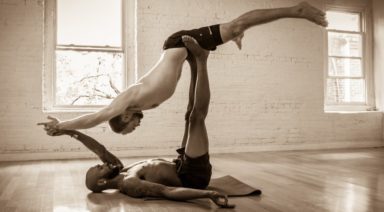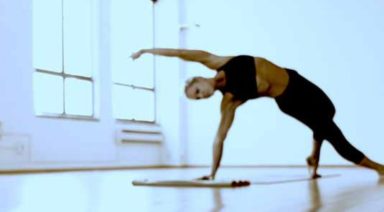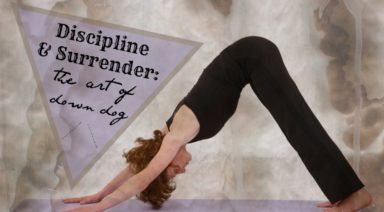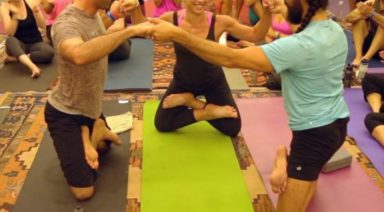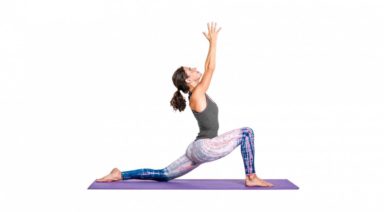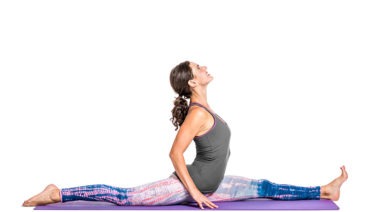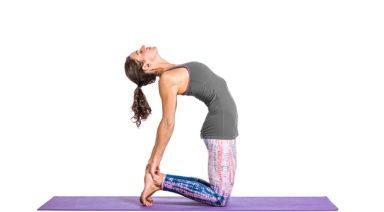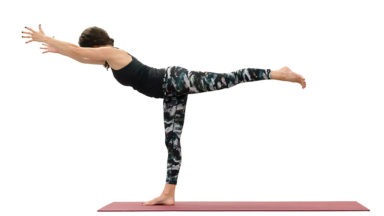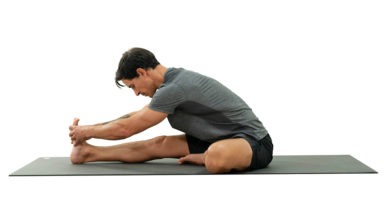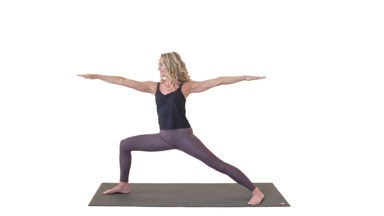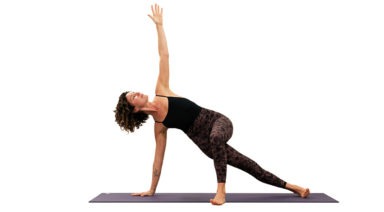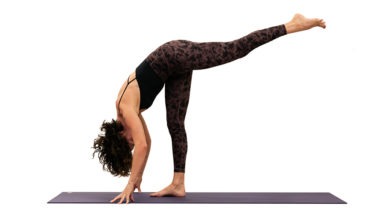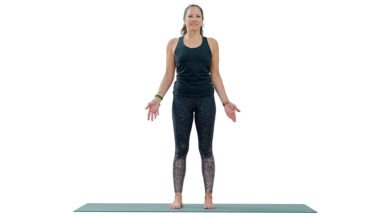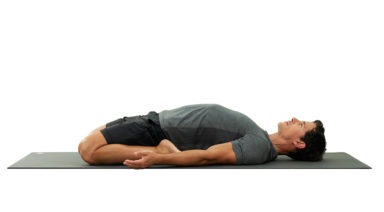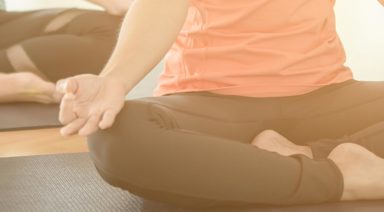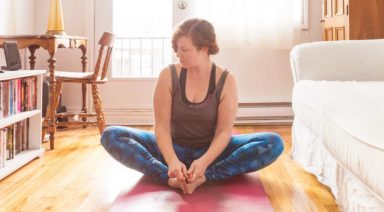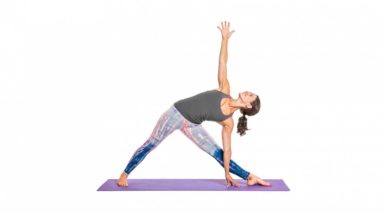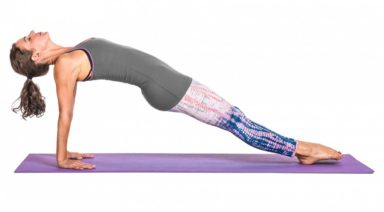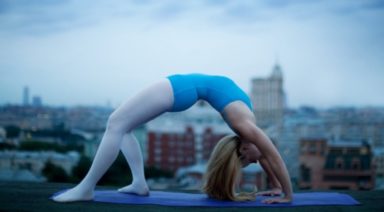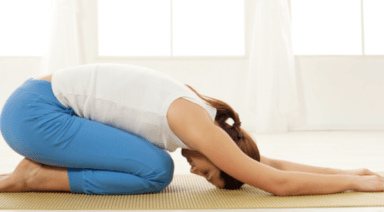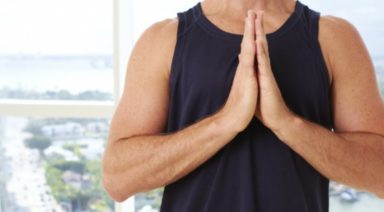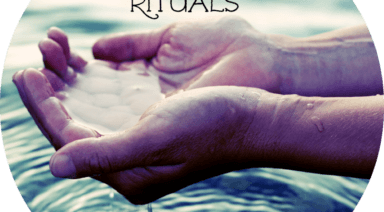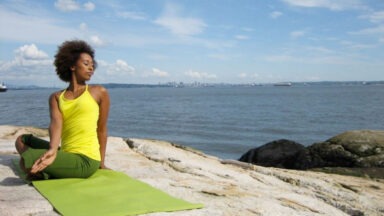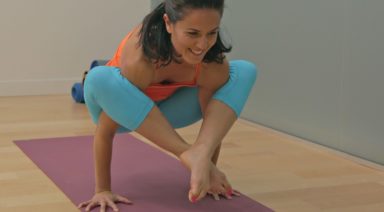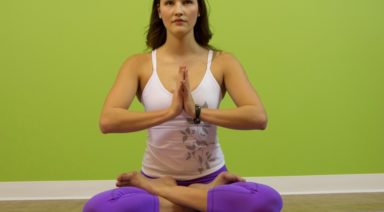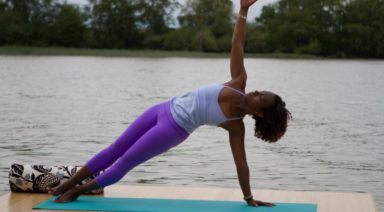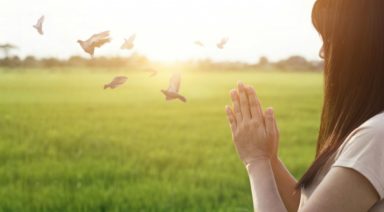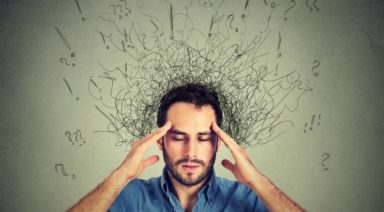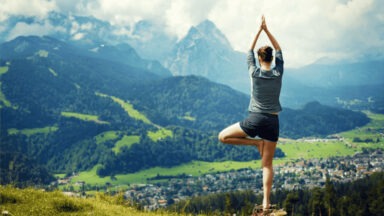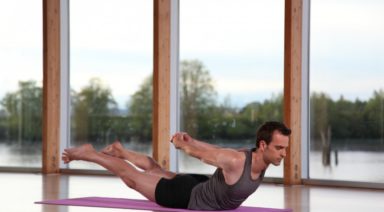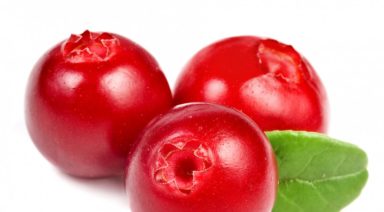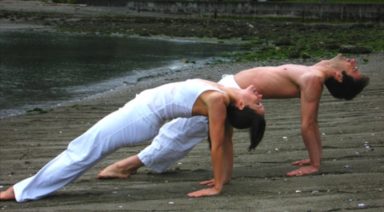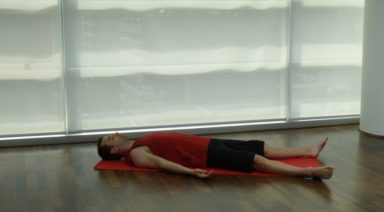Yin Yoga Poses
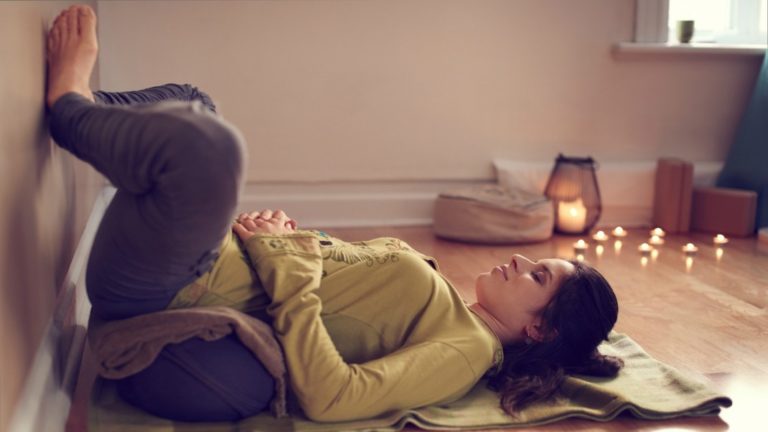
This article is an exploration of 10 Yin yoga poses. Yin is a style that is practiced by holding poses for a long time in a relaxed state. Yin stands in contrast to other contemporary styles of yoga, such as Vinyasa or Hatha, which generally move the practitioner from pose to pose quickly. Yin yoga ‘asana’, the Sanskrit word for poses, are practiced by following the three principles that Bernie Clark explains in Yin Yoga with Bernie Clark.
Three Principles of Yin Yoga
- Principal 1: Play with your edge
- Principal 2: Stillness
- Principal 3: Hold for Time
Play With Your Edge
Yin is a lunar practice, which tends to be healing and cooling. Unlike solar practices such as sun salutations, yin does not call for heating postures, breathing styles, or sequencing. Therefore the muscles are typically not warm throughout a Yin practice. Entering into poses with cool muscles requires special attention to the first edge.
The first edge is found by gently getting into the shape of a pose and noticing where the body naturally wants to stop. Yielding the natural limitations of the body prevents injury. There should be no pain at the first or any other edge, yet there may be some discomfort. Discomfort without radiating pain is a sign that the connective tissue around the joints is stretching. Reasonable discomfort is a gateway to more flexibility and greater range of motion. Props can add additional comfort and accessibility to yin yoga poses.
You may experience strong physical sensations during a Yin practice such as heat or discomfort. Finding the first edge is a method of exploring the strong sensations and sitting with them. When yoga asana is briefly mentioned in the Yoga Sutras of Patanjali, they are prescribed to be Sthira sukham asanam, or done with steadiness and ease. Steadiness points to the second principal, stillness, which is explored later in the article.
About 30-60 seconds into a pose, or if and when the body shows signs of being able to go deeper, it is safe to move to the second edge (or third or forth). It is important that the body, not the ego, give the signal to deepen. This humble practice never asks the yogi to prove or force anything. There is no need to try to “achieve” or to look a certain way. Gentleness, acceptance and honesty are critical in a yin practice. If the body starts to tighten, it’s a sign to slowly come out of the pose.
Stillness
Classical yoga was practiced as a means to still the mind for meditation. Sitting still in yin yoga poses lets the contemporary yogi dip their toes into the waters of deep meditation. One exception to stillness is when the body opens to a new edge. With the awareness that the body is ready to deepen, Yin yogis consciously move deeper and return again to stillness and breath. Another exception to stillness is the awareness of pain. In response to pain, it’s time to come out of the pose slowly.
Hold for Time
The third principal is to hold the poses for time. Poses can last anywhere from one minute to longer than 15 and in general are done for 5-10 minutes. Using a timer tells you how long you are staying still, which can be a way to gauge stillness from practice to practice. A timer can also ensure that both sides of the body get the same amount of time, which results in feeling delightfully balanced. The breath can continue to deepen the longer a pose is held. The lungs can expand seemingly forever. Counting breath is an interesting way to observe the expansive nature of the breath, which becomes possible during long holds. Profound experiences become accessible only when conscious and deepening pranayama is practiced.
Breathing expansively while remaining still presents the practitioner with what is rarely otherwise observed: the quiet inner dance of consciousness, an inner world so rich and mysterious, it is invisible most of the time. Holding (still) for time never seemed so tempting.
What Do You Need to Practice Yin Yoga?
- Yoga mat or as an alternative, a thick blanket or carpet.
- Yoga blankets and bolsters or as an alternative, towels and pillows nearby
- Blocks or (or books if you have none)
Optional items
- Sand timer
- Soft music
- Candles
10 Yin Yoga Poses
1. Chest and Shoulder Expansion
Sit cross-legged, your right side adjacent to the wall, reach your right hand back so the palm is flat against the wall at about shoulder height. Scoot your right hip in closer to the wall if you feel you can safely tolerate more stretch. Once the shoulder feels settled, bend the arm so you have the palm directly above the elbow at the height of your gaze. Sit and breathe for several moments. If you feel you can safely deepen, allow the left hand to come beside and slightly behind your left hip and press fingertips into the floor. Lift and open your chest. Slowly drop the left shoulder down and perhaps the chin and gaze point follow. Stay for 1-5 minutes breathing gently.
2. Lower Back Pose
Sit on a cushion if you have tight hamstrings or flat on the mat for more open hamstrings. Let the legs extend and relax so that the feet flop out gently to their respective sides. Knees can be slightly bent. Pressing the fingertips downward into the ground beside the hips, lengthen the heart higher in contrast. Then tuck the chin into the chest. Let the upturned palms fall to the outside of the thighs near the knees. Allow the upper spine to round. For your second edge, the hands may move down the legs closer to the ankles. Remember not to strive or do too much. Stay and breathe 1-5 minutes.
3. West-Facing Pose
This pose just like the lower back pose, sitting up legs relaxed and extended. Place one bolster over your thighs. Lift though the chest as you inhale and as you exhale fold forward and down, hinging from the hips so as to keep length in the low back. If you are not able to lay upon the cushion, add more props until you can easily lay your chest and face on them. Find your first edge. At this time you may determine to remove or reduce the props so that you can go deeper. Stay in the pose for 1-5 minutes. Note, this pose is called “west-facing” because it is cooling, like the setting sun, which sets in the west.
4. Wide Leg Child Pose
On your mat, add cushion beneath the knees using a blanket or towel. Bring the knees as wide or wider than the mat and big toes to touch or towards one another. Press your hips back toward the heels and walk your hands forward as you fold from the hips. Imagine a gentle anchor keeps the hips downward and the low back spreading wide. From there, stretch the arms, chest and head forward and down. If the head cannot touch the floor, put a block or folded blanket beneath it so it can rest. You may prefer to rest upon the forehead or to turn the head to one side and then the other. Let your arms and hands relax into the floor. Notice your edge and deepen if and when it feels right. Come out if the knees start to bother you, moving slowly. Practice for 1-5 minutes.
5. Wide Leg Child Pose, Thread the Needle Variation
From wide leg child pose, slightly raise the head and walk the right hand back. Thread the right hand under the left until the right shoulder is on the ground and put the right temple on the floor. Repeat on the left side. Practice 1-5 minutes on each side.
6. Lizard
Come to your hands and knees with a folded blanket under the knees for padding. Bring your right foot forward so it is just to the right on the right hand, make sure your shoulders are over the wrists. The right knee stacks over the right ankle so your shin may feel as though it is moving forward in space. If the right knee pops out to the right, redirect it over the ankle, pressing down into the right foot and imagine pressing the shin forward.
If needed, bring your hands up on blocks, lift through the chest, curl the left toes under and squeeze the left leg so the thigh lifts off the ground. This will cause the thigh to rotate internally, which means the alignment is now safe for deepening. Now , bringing the left knee down onto the blanket and then flatten the top of left foot into the mat. You may stay like that or bring your elbows onto the blocks to deepen. You may end up with no blocks, elbows on the mat beneath the shoulders or you may end up staying high on blocks. Honor where the body needs to go and remain for 1-5 minutes before repeating on the other side.
7. Pigeon
Place a flat bolster horizontally across the mat or a folded blanket about halfway down the length of the mat. Place both knees on the bolster. Bring the right knee forward of the cushion in front of the right hip and the foot toward on left side of the mat. Place the palms on blocks beneath the shoulders and bring the left leg back so that the thigh and top of left foot are pressing into or towards the floor. Let the pelvis be supported by the cushion. You may stay upright, opening the chest, or choose to ease yourself down, perhaps deepening to the point where your head rests on blocks or on the floor. Remain in the pose 1-5 minutes and repeat on the other side.
8. Supported Reclined Butterfly
The use of props to recline makes this supportive and relaxing. To do so, place a block the tall way and another the short way so they make an L. Lay a bolster or supportive cushion over the blocks so that it a slanted toward the floor. Place yourself with your back against the lower part of the cushion with the souls of your feet touching. To keep the feet together and to allow the hips to relax, use a strap or a long rolled blanket to wrap the feet.
9. Supported Gentle Fish
Place a block at medium height near the top of the mat. Sit so the block is behind you with the legs extended and relaxed. Lay your back over the blocks so they land between your shoulder blades boosted your heart up. Let your head relax back onto a block, making sure the neck is supported. Allow the arms to pour open and drip into the floor on either side. Breathe into the heart and let the body seep down onto the props. As your edge moves, notice the chest may boost higher. Remain 1-5 minutes.
10. Corpse Pose/ Savasana
Lay on the mat on your back. Let the arms and legs relax. Arms by your sides, feet slightly flop out. If your lower back is uncomfortable place blocks or a cushion under the knees. Stay as long as you wish. Let go of doing and drop into being.
Photos courtesy of author Lara Hocheiser and featuring Blair Smalls.
Partner Yoga Poses: The Power of Connectivity
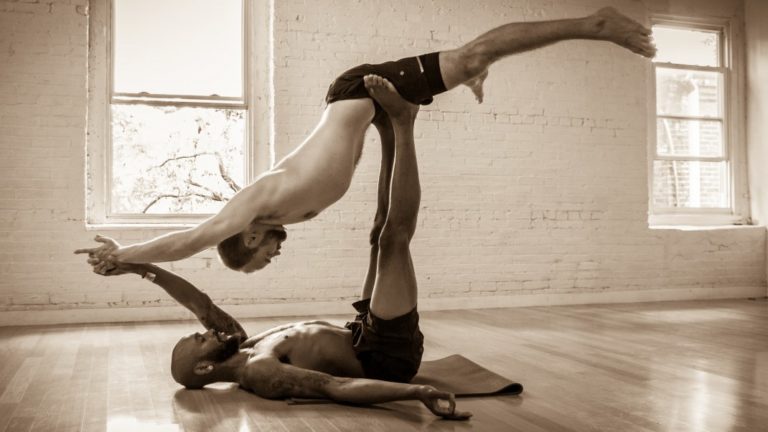
Want to heighten your yoga experience? Deepen your practice through body and mind with partner yoga: Partner Yoga Level One and Partner Yoga Level Two, led by instructor Pedro Franco, are perfect for yoga lovers. Partner yoga is a practice for any level of yogi. It can be done with a friend, loved one or acquaintance. Through this fun and connected series, you will learn to strengthen and amplify your practice by creating a greater sense of awareness in your own body while also paying close attention to the presence and movements of your partner. Partner yoga poses are great if you want to try something new or to spice things up in your relationship with more intimate couples yoga poses.
Things to Keep in Mind When You Start Your Partner Practice
- Partner yoga does not have to be complicated to be beneficial
- Partner yoga can simply be sitting back-to-back with your partner and breathing. It can be meditative. It can be as simple as massaging your partner’s sacrum after a stretch or wiggling your partner’s legs after a flying pose
- Partner yoga works on the same principles as individual yoga: Listen to your body and do what feels right. Challenge yourself, but only to a healthy limit
- If you’re new to partner yoga, take time to build strength, stability and flexibility in order to grow in the practice. Remember that in any form of yoga, there is no competition. For as many times as you stumble, you have just as many opportunities to try again. It is the act of connecting that matters most, not reaching a pose
Start with a Simple Partner Yoga Pose
Partner yoga can be a challenge for even the most advanced practitioner: It doesn’t matter how many hours you have spent on your mat, how many downward dogs or side crows you have done in your life. Maybe you are focused and resilient but need to work on your strength. Maybe you are strong and advanced in your movements but need to work on the act of giving yourself to your partner in a selfless manner.
Partner Seated Spinal Twist (Janu Sirsasana)
-
Begin by sitting back-to back in a comfortable cross-legged seated position
-
Each partner places their right hand on the other’s partner’s left thigh just above knee
-
Put your left hand on your own right knee
-
Coordinate your breathing by lengthening through spine on each inhale
-
During each exhale, twist a little more
-
Come back to center seated and repeat on other side
Learn the Art of Balancing with Your Partner
Partner yoga is not just about you. It is about the other person, too. Partner yoga poses exist to teach yogis and anyone interested in the practice how to gain better awareness and alignment of the body through precise adjustments and articulated movements.
Partner Boat Pose (Navasana)

-
Start by having each partner sit at the end of the mat facing each other
-
Each partner will bend their knees and press the soles of their feet together
-
Connect by clasping each other’s hands
-
While keeping the soles of your feet together, lean back slowly
-
Lengthen your legs and reach your feet upward to a bent-legged boat pose
-
Continue to breathe while you work on your balance
Create Greater Intimacy with Your Partner
Partner yoga can be as intimate as you allow it to be. Partner yoga is for anyone and everyone. It is about trust. It is about connection. It is about feeling the electric sensation between you and another person. It has the power to strengthen bonds between friends, unite strangers and fuse couples together in a new and stimulating way. Partner yoga has the powerful ability to create a profound level of intimacy between two people. The combination of breath, balance, trust and connection create for a unity that is unlike any other. It is assumed by many that partner yoga is purely sexual. This is not true. Yes, partner yoga can be a sensual experience if you want it to be, especially in couples yoga poses. It can also be an experience of unity in a completely different way. It can be whatever you want it to be. That is the beauty of the practice.
Partner Dancer’s Pose (Nataranjasana)

-
Start by standing up toward the back edge of your mat, facing your partner
-
Grab your partner’s right hand
-
Each partner will slightly bend the knees
-
Shift your weight onto your right leg
-
Bend the left knee and gran onto the inside of the left ankle or calf with your left hand
-
Gently pressing your shin into your left hand, open your back
-
Finally, reach your right arm up to balance
-
Repeat on the other side
Connect with Your Partner
Partner yoga is not just about you. Partner yoga has the word partner in it for a reason. It is a practice for two and is a practice that focuses on the unity of two. This is the idea that we should be incorporating in our partner yoga practice. Listen to your partner’s needs. Are they comfortable? Do they feel supported? Do they feel capable of holding you in a pose? Are they calm and present? Through the power of breath and touch, you will be able to sense your partner’s physical and emotional state. Yes, you need a partner to fly. You need a partner to pull your legs and lift you up. But your partner also needs you. It all comes back to unity. In these partner yoga poses and couples yoga poses, we rely on each other and so we must move in a way that represents that.
Double Standing Forward Bend (Uttanasana)
-
Stand back-to-back with your partner
-
Leave about 6 to 12 inches between you and your partner’s heels
-
Each partner will bend at the waist and come to a forward fold
-
Reach your hands behind you
-
Grab onto your partner’s hands
-
As you increase flexibility, you may be able to grab your partner’s forearms, elbows or even shoulders
-
Walk your heels closer until your bottoms are touching and straighten your legs
-
Lengthen the spine, head dangling toward the ground
Explore AcroYoga
AcroYoga is the combination of yoga, massage and acrobatics. As with partner yoga, which often includes acrobatic poses, shown in the Partner Yoga Level Two video, it is important to focus on the building blocks of your practice. Start with what you know and allow yourself to grow through continual practice, one step at a time. Motivation and repetition are the keys to helping you excel at AcroYoga. A common misconception about AcroYoga is that the size of your partner matters. This is not always true. Believe it or not, you have the ability to lift someone twice your weight. It is all about your technique.
As an extension of partner yoga, AcroYoga relies on the same principles: trust, communication and connection. Once you master these skills, you will be flying in the air and lifting people up with your feet in no time. Here is a fun beginner’s partner AcroYoga pose to test out your skills.
Flying Plank (A)
-
Base lies on back
-
Base places legs up in the air, heels over hips
-
Flyer starts by standing facing the base, with their toes almost touching the base’s glutes
-
Base bents knees slightly to bring feet to the hipbones of the flyer
-
Base and flyer connect hands, palm to palm and fingers interlaced
-
Flyer leans forward into the base’s feet
-
With flyer’s body in a single line, the base will receive the weight of the flyer in their feet
-
Base will then straighten their legs and stack their heels directly over the flyer’s hips
-
The flyer should have an engaged core, and the base should have straight arms and shoulder blades firmly grounded into the mat for maximum support and balance
From Flying Plank, yogis can work into the variation below: the flyer leans into the base’s hands instead of feet.

Flying plank photo credit: Amy Goalen
Just as we protect our family, friends and loved ones, we must protect each other when practicing partner yoga. Emotionally and physically, we must rely on each other to reach the ultimate goal of unity and connection.
Thank you to Amy Goalen for providing the beautiful main article image!



